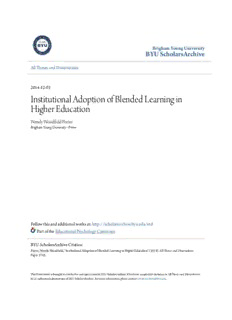
Institutional Adoption of Blended Learning in Higher Education PDF
Preview Institutional Adoption of Blended Learning in Higher Education
BBrriigghhaamm YYoouunngg UUnniivveerrssiittyy BBYYUU SScchhoollaarrssAArrcchhiivvee Theses and Dissertations 2014-12-01 IInnssttiittuuttiioonnaall AAddooppttiioonn ooff BBlleennddeedd LLeeaarrnniinngg iinn HHiigghheerr EEdduuccaattiioonn Wendy Woodfield Porter Brigham Young University - Provo Follow this and additional works at: https://scholarsarchive.byu.edu/etd Part of the Educational Psychology Commons BBYYUU SScchhoollaarrssAArrcchhiivvee CCiittaattiioonn Porter, Wendy Woodfield, "Institutional Adoption of Blended Learning in Higher Education" (2014). Theses and Dissertations. 5762. https://scholarsarchive.byu.edu/etd/5762 This Dissertation is brought to you for free and open access by BYU ScholarsArchive. It has been accepted for inclusion in Theses and Dissertations by an authorized administrator of BYU ScholarsArchive. For more information, please contact [email protected], [email protected]. Institutional Adoption of Blended Learning in Higher Education Wendy Woodfield Porter A dissertation submitted to the faculty of Brigham Young University in partial fulfillment of the requirement for the degree of Doctor of Philosophy Charles R. Graham, Chair Randall S. Davies Peter J. Rich Richard E. West David D. Williams Department of Instructional Psychology and Technology Brigham Young University December 2014 Copyright © 2014 Wendy Woodfield Porter All Rights Reserved ii ABSTRACT Institutional Adoption of Blended Learning in Higher Education Wendy Woodfield Porter Department of Instructional Psychology and Technology, BYU Doctor of Philosophy Relatively little research on blended learning (BL) addresses institutional adoption in higher education. Graham, Woodfield, and Harrison (2012) proposed a framework for institutional BL adoption, identifying three stages: (a) awareness/exploration, (b) adoption/early implementation, and (c) mature implementation/growth. The framework also identified key strategy, structure, and support issues universities may address at each stage. In this series of articles, the authors applied that framework to institutions of higher education implementing BL. In the first article, the authors applied the framework to 11 Next Generation Learning Challenge (NGLC) grant recipients transitioning from Stage 1 to Stage 2 of BL adoption. The authors compared U.S. institutional strategy, structure, and support approaches to BL adoption and identified patterns and distinctions. In the final two articles, the authors applied the framework as well as Rogers’ (2003) diffusion of innovations theory to determine the degree to which and why institutional strategy, structure, and support measures would facilitate or impede BL adoption among higher education faculty. The authors also explored whether faculty’s innovation adoption category would affect which measures facilitated or impeded BL adoption. To achieve these objectives, the authors surveyed and interviewed faculty at BYU-Idaho (BYU-I). In the second article, the authors reviewed the survey results to determine (a) the appropriate innovation adoption category for each faculty member and (b) the factors that impacted faculty decisions to adopt BL. In the third article, the authors reviewed the results of the interviews to identify why participants reported strategy, structure, and support decisions would impact their decision to adopt BL. Keywords: post-secondary education, blended learning, hybrid courses, faculty adoption, institutional adoption, higher education policy iii ACKNOWLEDGEMENTS To my parents, Linda and Scott Woodfield, who taught me how to live and how to work hard. To my husband and favorite person, Ben, who lovingly supported me through this process. To my chair, Charles, who befriended and patiently mentored me. To my committee, Randy, Peter, Rick, and David, who provided outstanding feedback and support. iv TABLE OF CONTENTS ABSTRACT .................................................................................................................................... ii ACKNOWLEDGEMENTS ........................................................................................................... iii TABLE OF CONTENTS ............................................................................................................... iv LIST OF FIGURES ........................................................................................................................ x LIST OF TABLES ......................................................................................................................... xi DESCRIPTION OF RESEARCH AGENDA AND STRUCTURE OF THE DISSERTATION ............................................................................................................................ 1 Article One .................................................................................................................................1 Article Two ................................................................................................................................2 Article Three ..............................................................................................................................2 Journal Submission ......................................................................................................................... 3 Contribution .................................................................................................................................... 3 Article 1 Blended Learning in Higher Education: Institutional Adoption and Implementation .................... 4 Abstract ........................................................................................................................................... 5 Introduction ..................................................................................................................................... 6 Literature Review............................................................................................................................ 8 Strategy ......................................................................................................................................8 Purpose .................................................................................................................................8 Institutional advocacy. .......................................................................................................10 Definition. ..........................................................................................................................10 Structure ...................................................................................................................................10 v Infrastructure. .....................................................................................................................10 Scheduling..........................................................................................................................11 Governance. .......................................................................................................................11 Evaluation. .........................................................................................................................11 Professional development. .................................................................................................12 Support .....................................................................................................................................13 Technical and pedagogical support. ...................................................................................13 Institutional incentives. ......................................................................................................13 Method ...........................................................................................................................................14 Case Selection ..........................................................................................................................14 Data Collection ........................................................................................................................17 Data Analysis ...........................................................................................................................17 Findings..........................................................................................................................................18 Strategy ....................................................................................................................................20 Purpose. ..............................................................................................................................20 Institutional advocacy. .......................................................................................................21 Definition. ..........................................................................................................................22 Structure ...................................................................................................................................23 Infrastructure. .....................................................................................................................23 Scheduling..........................................................................................................................24 Governance. .......................................................................................................................24 Evaluation. .........................................................................................................................25 Professional development. .................................................................................................25 vi Support .....................................................................................................................................26 Technical and pedagogical support. ...................................................................................26 Institutional incentives. ......................................................................................................27 Discussion ......................................................................................................................................28 Strategy ....................................................................................................................................29 Purpose. ..............................................................................................................................29 Institutional advocacy. .......................................................................................................29 Definition. ..........................................................................................................................30 Structure ...................................................................................................................................31 Infrastructure. .....................................................................................................................31 Scheduling..........................................................................................................................31 Governance. .......................................................................................................................31 Evaluation. .........................................................................................................................32 Professional development. .................................................................................................32 Support .....................................................................................................................................33 Technical and pedagogical support. ...................................................................................33 Institutional incentives. ......................................................................................................34 Conclusion .....................................................................................................................................34 References ......................................................................................................................................37 Appendix A ....................................................................................................................................43 Article 2 vii Institutional Drivers and Barriers to Faculty Adoption of Blended Learning in Higher Education .......................................................................................................................................48 Abstract ..........................................................................................................................................49 Introduction ....................................................................................................................................50 Literature Review...........................................................................................................................51 BL Definition ...........................................................................................................................51 Faculty Adoption Research ......................................................................................................52 Institutional BL Adoption Framework.....................................................................................53 Rogers’ Diffusion of Innovations ............................................................................................54 Method ...........................................................................................................................................56 Research Context .....................................................................................................................56 Data Collection ........................................................................................................................57 Data Analysis ...........................................................................................................................58 Findings..........................................................................................................................................61 Respondent Demographics and Overall Results ......................................................................61 Self-Categorization and BL Adoption Scores..........................................................................63 Influential Decisions for Individual Innovation Adoption Categories ....................................65 Discussion ......................................................................................................................................67 Self-Categorization and BL Adoption Scores..........................................................................67 Overall Results .........................................................................................................................68 Innovators, Early Adopters, and the Early Majority ................................................................69 The Late Majority and Laggards..............................................................................................69 Conclusion .....................................................................................................................................70 viii References ......................................................................................................................................73 Appendix A ....................................................................................................................................77 Article 3 A Qualitative Analysis of Institutional Drivers and Barriers to Blended Learning Adoption in Higher Education ...........................................................................................................................82 Abstract ..........................................................................................................................................83 Introduction ....................................................................................................................................84 Literature Review...........................................................................................................................85 BL Definition ...........................................................................................................................85 Faculty Adoption Research ......................................................................................................86 Institutional BL Adoption Framework.....................................................................................87 Rogers’ Diffusion of Innovations ............................................................................................88 Method ...........................................................................................................................................90 Research Context .....................................................................................................................90 Data Collection ........................................................................................................................91 Data Analysis ...........................................................................................................................93 Findings and Discussion ................................................................................................................94 Demographics of Interviewees ................................................................................................94 Strategy ....................................................................................................................................95 Purpose ...............................................................................................................................96 Advocacy ...........................................................................................................................97 Definition/Policy ................................................................................................................99 Structure .................................................................................................................................100 ix Infrastructure ....................................................................................................................101 Evaluation ........................................................................................................................102 Professional development ................................................................................................103 Governance ......................................................................................................................105 Schedule ...........................................................................................................................106 Support ...................................................................................................................................107 Technological support ......................................................................................................108 Pedagogical support .........................................................................................................109 Course load reductions .....................................................................................................110 Financial stipends.............................................................................................................111 Tenure/Promotion ............................................................................................................111 EM and LM Distinctions .......................................................................................................113 Strategy ............................................................................................................................114 Structure ...........................................................................................................................114 Support. ............................................................................................................................116 Conclusion ...................................................................................................................................116 References ....................................................................................................................................118 Appendix A ..................................................................................................................................122 Appendix B ..................................................................................................................................127 DISSERTATION CONCLUSION ..............................................................................................130 Dissertation References ...............................................................................................................133 Dissertation Appendix A..............................................................................................................134
Description: